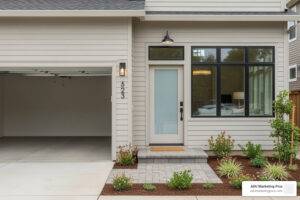Why Your ADU Business Needs a Website That Converts
ADU Website Design has become critical as California’s accessory dwelling unit permits surged from 1,269 in 2016 to 14,702 in 2019—an 11-fold increase that shows no signs of slowing. With homeowners increasingly turning to online research before choosing contractors, your website isn’t just a digital business card—it’s your most powerful sales tool.
Essential ADU Website Design Elements:
– Project galleries with before/after photos and floor plans
– Interactive tools like cost calculators and 3D configurators
– Trust signals including permits, testimonials, and certifications
– Educational content about regulations, timelines, and benefits
– Mobile-responsive design for homeowners searching on-the-go
– Clear calls-to-action for consultations and quote requests
Modern homeowners expect to preview your work, understand pricing ranges, and feel confident about regulations before they ever pick up the phone. Your website needs to educate nervous homeowners about zoning laws, showcase your expertise through completed projects, and convert visitors into qualified leads.

What You’ll Learn
In this comprehensive guide, we’ll walk you through everything needed to create a high-converting ADU website. You’ll find growth statistics that prove the importance of online presence, essential trust signals that homeowners look for, the best WordPress templates for construction businesses, and proven lead generation strategies that turn website visitors into paying clients.
Why Every ADU Business Needs a Digital Home
Accessory Dwelling Units (ADUs) are self-contained living spaces with their own kitchen, bathroom, and sleeping area, built on the same property as a main home. These versatile units are solving real problems—from housing shortages to helping families live closer together while generating rental income.
If you’re an ADU contractor, architect, or designer, having a strong online presence isn’t just nice to have—it’s essential for survival. Your website becomes your hardest-working employee, building trust with homeowners before they ever meet you in person. When done right, ADU Website Design transforms skeptical browsers into confident clients.
Modern homeowners do their homework online first. They want to see your completed projects, understand your design process, and feel confident that you know local building codes. Without a professional website showcasing your expertise, you’re practically invisible to this growing market.
The ADU Boom & Online Search Habits
California’s legislative reforms have created unprecedented ADU growth. The state has reduced impact fees, relaxed parking requirements, streamlined permitting, and decreased setback requirements. Permit applications have surged from barely over a thousand in 2016 to nearly fifteen thousand just three years later.
Homeowners are conducting mobile searches while standing in their backyards, imagining what’s possible with their space. Your website needs to capture their attention during these crucial moments.
For deeper insights into industry trends, check out The ADU Hour podcast, where experts discuss everything from design principles to regulatory updates.
Building Credibility Before the Site Visit
Your website serves as your first job interview with every potential client. Before homeowners ever shake your hand, they’re making judgments about your professionalism, expertise, and trustworthiness based entirely on what they see online.
Social proof becomes your secret weapon. Detailed testimonials, project completion statistics, and industry certifications establish your authority. Project data that demonstrates your track record and clear explanations of your process help homeowners feel informed rather than overwhelmed.
Mastering ADU Website Design Essentials
Building a successful ADU Website Design starts with understanding your audience: homeowners who are excited about adding an ADU but nervous about the complexity. Your website needs to feel as welcoming as the beautiful spaces you create.
Your branding should reflect the quality craftsmanship you bring to every project. Professional yet approachable design builds trust with homeowners making a significant investment. Responsive design isn’t just nice to have—it’s absolutely essential. Your site needs to work perfectly on mobile devices when homeowners browse ADU ideas on their phones.
If you’re an architectural firm looking to specialize in ADUs, you’ll find additional insights in our Architect Website Design guide.
Information Architecture for ADU Website Design
Great ADU Website Design starts with navigation that makes sense to real people. Your site structure should feel as intuitive as walking through one of your completed ADUs.
Your services overview should clearly explain what you do without industry jargon. Your project gallery works best when organized by what homeowners care about—detached units, garage conversions, or studio spaces.
A zoning and regulations guide custom to your local area instantly positions you as the expert. Your FAQ section should address real questions: “How long does permitting take?” “Can I add a kitchen?” “What about parking requirements?”
Visual Branding for ADU Website Design
Your visual identity tells a story before visitors read a single word. Colors should feel like the homes you build—warm, inviting, and thoughtfully designed.
Lifestyle photography is your secret weapon. Show families cooking together in ADU kitchens or young adults enjoying their first independent space. These images help visitors picture their own lives in your ADUs.
Floor plan renderings prove your technical expertise while helping homeowners understand spatial relationships. Consider adding simple annotations that make your designs more accessible.

Content Must-Haves
Your website content should answer the questions keeping homeowners up at night. Detailed floor plans with clear square footage help them visualize possibilities. Honest cost ranges build trust—nobody likes surprises with major investments.
Regulatory information specific to your service areas saves homeowners hours of research. Consultation call-to-actions should feel like friendly invitations rather than pushy sales pitches.
| Template | Best For | Key Features | Price Range |
|---|---|---|---|
| Divi | Versatile customization | Drag-and-drop builder, responsive design | Premium |
| Astra | Speed and SEO | Lightweight, fast loading, highly customizable | Free/Premium |
| Neve | Modern aesthetics | Mobile-first design, WooCommerce integration | Free/Premium |
| Zeen | Visual portfolios | Eye-catching layouts, gallery options | Premium |
Showcasing Projects, Tools & Converting Clicks to Clients
Your project showcase is where curious homeowners become excited clients. Think of it as your digital showroom, where every photo, video, and interactive element works together to tell the story of what’s possible in their backyard.
Modern homeowners want to experience your work before they commit. The most successful ADU websites incorporate 3D configurators that let visitors play with different layouts, cost calculators that provide instant estimates, and video tours that make them feel like they’re walking through their future ADU.
Integration with scheduling tools like Calendly removes friction from the booking process. For inspiration, check out Studio Shed’s design configurator, which lets users customize and price designs in real-time.
For broader marketing strategies, see our ADU Builder Marketing Strategy guide.
Portfolio That Sells
Your portfolio needs to sell dreams, not just show carpentry skills. Each project should tell a complete story that helps visitors see themselves in similar situations.
Before-and-after sliders show change. That cramped garage becomes a bright studio apartment. Include project details like square footage, timeline, and special challenges. Add client testimonials that highlight both the final result and the experience of working with you.
Interactive maps showing project locations build credibility by demonstrating local expertise. Include ROI statistics where appropriate—when homeowners see similar ADUs generating $2,500 monthly rental income, the investment becomes compelling.

Smart Lead Generation
Smart ADU Website Design uses lead generation strategies that help visitors while capturing valuable project information.
Multi-step forms work beautifully because they mirror the natural planning process. Start with simple questions like “What type of ADU interests you?” and gradually gather details about timeline, budget, and needs.
Chatbots handle common questions 24/7, like “Do I need a permit?” or “What’s the typical timeline?” Consider offering gated content like comprehensive planning guides or local zoning checklists.
Low-cost consultation offers remove barriers to engagement. A $99 feasibility assessment with credit toward full services gives homeowners a low-risk way to get started.
Enhancing Trust With Online Tools
Interactive tools provide immediate value while showcasing your expertise and customer-focused approach.
Live pricing calculators based on square footage and local market conditions give homeowners instant gratification. Permit timeline widgets showing expected approval timeframes address homeowners’ biggest concerns.
AR preview tools that let homeowners visualize ADUs on their property using their phone camera create incredibly engaging experiences. Websites with these advanced features build trust faster and generate higher-quality leads.
SEO, Speed & Ongoing Care
Your ADU Website Design success depends on technical performance that visitors can feel and search engines can measure. When your site loads slowly, potential clients bounce away before seeing your project galleries. Google uses Core Web Vitals—loading speed, click responsiveness, and visual stability—as actual ranking factors.
Schema markup helps Google understand your content, making your business appear in search results with star ratings, project photos, or pricing information. Local SEO becomes critical since most homeowners search for contractors within their immediate area.
Your site needs HTTPS encryption for security and search rankings. Regular backups protect your work and client information. Keeping plugins updated prevents security threats.
For comprehensive strategies, check out our SEO for ADU Companies guide.
Technical SEO for ADU Website Design
Think of your site structure as the foundation—everything builds on top of it. Clean, descriptive URLs work better than confusing strings. Use meaningful paths like /services/detached-adu-design/ instead of /page123/?id=abc.
Metadata optimization ensures your pages look appealing in search results. Every page needs unique title tags and descriptions that include relevant keywords naturally.
Image compression keeps project photos loading quickly without looking pixelated. Proper alt text helps visually impaired visitors while giving search engines context. Lazy loading means photos only load when visitors scroll to them.
Maintenance & Security Best Practices
Website maintenance keeps your digital presence running smoothly when you’re busy with actual projects. Software updates fix security vulnerabilities and add features. Security monitoring with firewalls catches threats before they damage your site.
Uptime monitoring alerts you if your site goes down. Analytics reviews help you understand which pages attract visitors and where people drop off. Regular maintenance separates professional businesses from those that lose leads to preventable problems.
Common Mistakes & How to Avoid Them
We’ve seen ADU businesses lose potential clients because their websites make easily avoidable mistakes. The most common culprit? Slow loading times that frustrate homeowners and hurt search rankings. When someone’s excited about adding an ADU, waiting 10 seconds for your gallery to load kills that enthusiasm.
Generic stock photos are trust-killers. Nothing says “we don’t actually build ADUs” like random construction workers in hard hats. Homeowners want to see your actual projects, even if you only have three completed ADUs.
Vague pricing information leaves potential clients guessing. Phrases like “competitive pricing” don’t help anyone. Homeowners need realistic cost ranges to determine if an ADU project fits their budget.
Missing mobile optimization is particularly damaging. Homeowners often browse while standing in their backyards. If your site looks broken on their phone, they’ll move to a competitor.
The biggest content mistake is missing permit and regulation information. When your website doesn’t address zoning concerns, visitors leave feeling confused rather than confident.
Fixing Poor ADU Website Design Choices
Clear, specific content always outperforms vague marketing language. Instead of “We build amazing ADUs,” try “We design and build 400-1200 square foot detached ADUs in Santa Clara County, with most projects completed within 6 months.”
Real project photography builds trust in ways stock images never can. Take photos during different construction stages to show your process, not just final results.
Strategic internal linking helps visitors find related information while boosting search rankings. When mentioning garage conversions, link to examples in your project gallery.
Future-Proofing Your Site
Choose a scalable content management system that can grow with your business. WordPress with flexible themes makes it simple to add new service areas or showcase additional project types.
Modular design templates give you flexibility to adapt as your business evolves. Maybe you start with basic design services but later add permit assistance or interior design packages.
Growth tracking through analytics helps you understand which content generates leads. Use this data to optimize your content and improve conversion rates over time.
Frequently Asked Questions about ADU Website Design
How can a website help me steer complex ADU regulations?
Your website becomes your regulatory command center—both for you and your clients. Creating detailed guides about local zoning requirements, permit processes, and regulatory changes positions you as the neighborhood ADU expert while calming nervous homeowners.
When someone can find clear answers about height restrictions in Palo Alto or parking requirements in San Jose right on your site, they’re already halfway to trusting you with their project. Create location-specific pages for different cities in your service area, since ADU regulations change dramatically from one city to the next.
Which WordPress theme is best if I need a project gallery fast?
If you need stunning project galleries up quickly, Astra and Neve are your best options. Both themes come with excellent built-in gallery features requiring minimal setup—perfect when you’re juggling construction projects and trying to launch your website.
Both are lightweight themes that won’t slow down your site, even with image-heavy portfolios. Divi offers more customization but requires more setup time. Choose based on your comfort level with technology and available time.
What online tools boost homeowner trust the quickest?
Cost calculators and permit timeline tools are game-changers for building instant credibility. When homeowners can plug in their lot size and get a ballpark estimate, you’ve solved their biggest initial question: “Can we actually afford this?”
Permit timeline widgets address the fear factor. When your website shows “typical permit approval: 8-12 weeks in San Mateo County,” you’re providing peace of mind and demonstrating local knowledge. These tools provide immediate value while positioning you as transparent and knowledgeable about the entire ADU development process.
Conclusion & Next Steps
Your ADU Website Design journey doesn’t have to be overwhelming. Think of it as building a digital foundation that’s just as solid as the ADUs you construct. Homeowners aren’t just looking for contractors—they’re seeking partners who can guide them through what feels like a complex, intimidating process.
Successful ADU websites follow a four-phase launch approach. You start by planning your content strategy around the questions homeowners actually ask. Then you design for the user experience, keeping mobile-first browsing in mind. Next comes implementing smart lead generation systems. Finally, you optimize for search visibility and conversion improvements.

What sets successful ADU businesses apart isn’t just pretty websites—it’s transparency and expertise. When you clearly explain permit timelines, share real project costs, and showcase authentic before-and-after photos, you’re building trust before that first phone call happens.
The ADU boom isn’t slowing down. California’s housing crisis and evolving regulations mean more homeowners are exploring accessory dwelling units every month. They’re doing their research online first. If your website doesn’t answer their questions and ease their concerns, they’ll find someone else’s that does.
Your website should feel like a helpful conversation, not a sales pitch. When homeowners can visualize their own ADU project through your portfolio, calculate rough costs with your tools, and understand the permit process through your guides, they’re already halfway to choosing you before you even meet.
At ADU Marketing Pros, we’ve seen how the right website transforms ADU businesses from price-competitive commodity services into trusted expertise partners. The difference is dramatic—both in the quality of leads and the profit margins those leads generate.
For a complete picture of how your website fits into your overall marketing strategy, check out our comprehensive ADU Marketing Strategies guide. Your website is powerful, but it’s even more effective when integrated with other marketing channels.
The opportunity in the ADU market is real and growing. Your website is the foundation for capturing that growth and building the kind of business that homeowners actively seek out rather than reluctantly choose.




